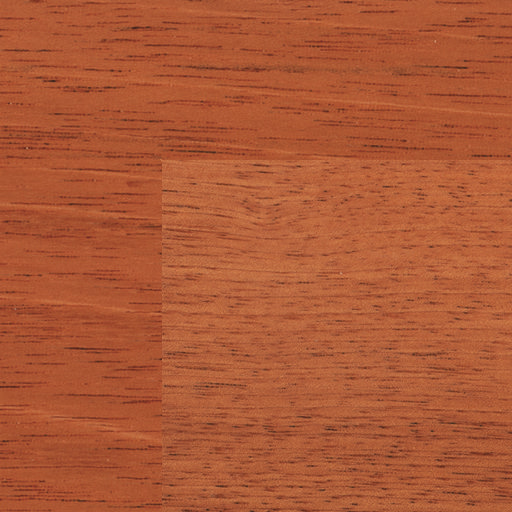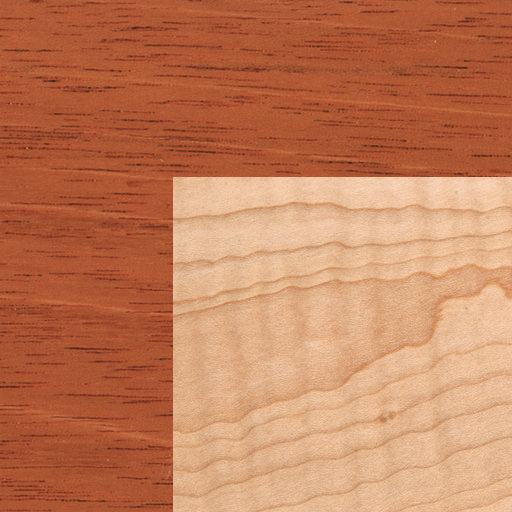For the top board, I can get spanish cedar, mahogany, and curly maple. Note that maple is not typically used for the top board, but the first uke I made has a curly maple top, and the instrument has a nice, bright sound. As a general guide to the tone these will produce, I’ve taken the following from tonewooddatasource.weebly.com:
Spanish Cedar Cedrela odorata H=3.7, M=3.5, B=3.6, S=4.6, O=3, T=2.3
Ranges from pinkish to a reddish-brown which will darken with oxidation to red brown or even a purplish tone. Fine texture, uniform grain, though denser, it’s tone is similar to mahogany and produces a light and rich sound with outstanding sustain and resonance coupled with excellent balance. Candy-like fragrance.
Mahogany Central and South America, Khaya sp.
Mahogany is a good wood to anchor a survey of tones, as a lot of other wood tones can be described in relation to it. Its essential sonic profile is well represented in the midrange frequencies. Acoustic guitars in general tend to live in the midrange portion of the sound spectrum, but mahogany in particular displays a lot of midrange character. That thick, present midrange sound is sometimes described in guitar circles as meaty, organic or even “chewy” — wherever a player digs in on the fretboard, they’re tapping into the core of the harmonic content of what a guitar produces. Those great midrange frequencies produce overtones that stack up and produce bloom, giving the sound extra girth. When one hears the resulting harmonics, the “chewy” tone serves up a big mouthful of midrange. As a popular tonewood for many decades, mahogany has been used on scads of old school acoustic recordings and that sonic heritage carries across various strains of roots music, from blues to folk to slack key.
Goes well with a broad range of players and musical style, people who like a well-balanced tone, nice dynamic range and a healthy serving of overtones. Blues and other rootsy players tend to respond well to mahogany’s midrange character. A smaller body mahogany guitar might appeal to fingerstyle players, whereas more aggressive flatpickers might opt for a mahogany Dreadnought. Because of mahogany’s midrange, a player with “dark hands” will tend to sound darker on a mahogany guitar. A bright player will sound slightly less bright.
As a back and side wood, mahogany has sometimes been considered a “poor man’s choice”, but there is now a great appreciation for its unique tonal qualities. It seems that mahogany ages well and its true value may not reveal itself until a few years have passed.
Genuine Mahogany is yellowish brown to reddish brown in color, exceptionally stable and consistently clear. It is much lighter in weight than rosewood, koa, or maple but yields a surprisingly strong loud sound with an emphasis on clear bright treble.
Maple Acer saccharum H=3.8, M=3, B=2.5, S=3.8, O=1.8, T=2
Maple is the only wood used for backs and sides in the violin family so it is well known to instrument makers, even though just a modest percentage of guitars are made with it. Of the 128 species, most are found in Asia yet most of the tonewood harvested is from North America. It is often under-rated and can be among the very most beautiful of the native American woods. The fact that it is a domestic wood augments its popularity. Maple is well known for imparting a bright tone to an instrument, good balance and projection, with excellent note separation and a tight bass (a guitar with good separation allows each note of a chord to ring independently as opposed to sounding thick or clustered). It requires less care for fluctuation in temperature and humidity than many other woods.
Well balanced sound on all 6 strings, one of the best tone woods and also one of the best neck woods. It really competes neck to neck with Brazilian rosewood and African Blackwood though on a different level… and, although normally bland and blond, the wood can look simply terrific. The great advantage of the species is that it is an American species, which translates in very little care when it comes to humidity conditions etc. It is very light compared to the tropical species but delivers with the same presence. It is one of the most beautiful woods and makes beautiful guitars. Often strikingly figured as “birds-eye”, “Quilted”, or “flamed”.
The hard maple harvested in the northeastern part of the United States is dense, moderately stiff, and has low to medium internal dampening. It produces a clear, cutting, bright, and fundamental targeted tone. Very responsive in the mid to upper register with clear although un-complex bass overtones. Sustains slightly better than softer maples.
Some Design Considerations
Aside from choice of woods, the biggest decision is the shape of the uke: conventional (figure 8) or pineapple. For other design considerations, I plan to use mahogany for the neck, and I will incorporate the primary woods used (for top, back & sides) into the tail stripe, heel cap, and headstock faceplate. Various combinations of wood I can use:
Cedar top, Bird’s eye maple back and sides
Cedar top, Curly maple sides, Bird’s eye maple back
Cedar top, Curly maple back and sides
Cedar top, Mahogany back and sides
Mahogany top, Bird’s eye maple back and sides
Mahogany top, Curly maple sides, Bird’s eye maple back
Mahogany top, Curly maple back and sides
Mahogany top, back and sides (next to koa, the most traditional)
Curly maple top, Mahogany back and sides
Final note: While I suppose I could make an all maple uke, I think it would be overpoweringly bright.








